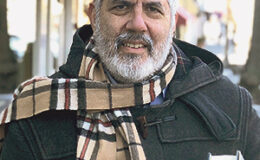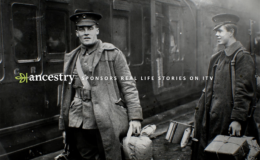
Support the news

It started innocently enough. A “yeah, sure” to her husband’s suggestion of taking a commercial DNA test. The kind advertised on TV offering a “more complete story of you” after you spit into a vial and drop it in the mailbox.
But for author Dani Shapiro, her results upended her world. Her late father — whom she’d loved and cherished for a half-century — wasn’t her biological father. It shook her, and her sense of self, to her core. But it also began a journey where secrets and consequences are confronted with grace.
In “Inheritance,” Dani Shapiro looks at family, genetics, genealogy and love.
On the idea to do a commercial DNA test
“It was what I’ve come to think of as recreational DNA exploration. [My husband] was just interested in the typical things that people often are when they do one of these tests — maybe finding a few third cousins, learning a little bit more about his family tree so that he could speak with his elderly parents about it, and he asked me if I wanted to do it as well. I just said, ‘Yeah, sure,’ but I wasn’t really curious. I just went along with it because he was doing it, too.
“I pretty much forgot about it after we sent our samples in. I just was surprised by the results a couple of months later. I had no suspicion. There was no part of me that had ever questioned my paternity.”
On her upbringing
“I grew up an only child. My parents were quite a bit older than the parents of most of my friends. My mother was almost 40 when I was born, which at that time was really unusual, and my father was a little bit older than my mother. We grew up in suburban New Jersey, and my father was from an Orthodox family and that was the defining part of his identity, and became a defining part of my identity growing up. I went to a Yeshiva, I spoke fluent Hebrew. It was a lovely childhood with everything that I could possibly have wanted in the way of having opportunities. And yet, there was a feeling that I always had that I had from the time I am able to remember of feeling somehow outside of things or like I didn’t belong or that something wasn’t right, something I could not put my finger on by that I felt to my bones.
“Every day of my life, somebody or another would say to me, ‘You don’t look Jewish. You can’t possibly be Jewish. Did your mother have an affair with the Swedish milkman?’ “
“I pretty much forgot about it after we sent our samples in. I just was surprised by the results a couple of months later. I had no suspicion. There was no part of me that had ever questioned my paternity.”
Dani Shapiro
On the results
“It came in an email, and the first thing that I saw was the breakdown of my ethnicity, my background. And I would have expected it to have been pretty close to 100 percent Eastern European Ashkenazi, because that’s where both my parents and their families were from, and instead it showed me to be just about 50 percent Eastern European Ashkenazi, and the rest was this smattering of English and Irish and French and German and a little Swedish.
“It didn’t alarm me, because of my certainty. We really form ourselves out of the stories that we’ve been told from the time we’re very, very young, and my story was that I was the child of both of my parents. I just thought a) maybe Ancestry got it wrong, b) perhaps all Jews are sort of 50 percent, the diaspora — maybe that’s normal. I was puzzled, but I didn’t freak out about it.
“When you do one of these DNA tests, you can opt in or opt out of seeing who you share DNA with. You don’t have to, but most people do because that’s why they’re doing it. I had opted in. There were a list of names of people that I was related to distantly that were names that were totally unfamiliar to me. But then this first cousin appeared — a male first cousin — identified by just initials. But it was somebody that was a total stranger.”
On further investigation
“I have a much older half-sister from an early marriage of my father’s, and I had recalled that she had told me, years before, that she had done DNA testing just to discover whether she had any hereditary conditions she should know about. And I remembered that, so I wrote her a note, and asked if she had her results. And she did, and she sent them to me right away.
“There is a site called GEDmatch, where you can upload two sets of results to see how closely those two sets of results are connected or related. So, as I write in the book, it took 0.04538 seconds, like a fraction of a second, for the results to come back. And they showed that we were not sisters, that we were not half-sisters, that we were not related.
“That was the moment, although I still thought it was possible that Ancestry had made a mistake … but I had a crushing realization that if this was true, that either our father wasn’t my half-sister’s father, or that he wasn’t my father. And I knew that if that was the calculation, that it meant he wasn’t my father.”
On her previous knowledge of the mystery surrounding her conception
“I had remembered, in its entirety, a conversation, one, single, conversation I had had with my mother many years earlier. It was the second anniversary of my father’s death, and I was a graduate student at Sarah Lawrence. I was giving a reading that night, and I invited my mother to come with me because I didn’t want her to be alone that night. She came with me to Westchester, where the school was, and I introduced her to a friend of mine who happened to be from Philadelphia. … My mother blurted out, ‘Oh, my daughter was conceived in Philadelphia.’
“By the time you’re 25 years old, if there’s a story to be told about your conception, a weekend in Paris, you’ve heard it, or you’re never going to hear it. But you don’t hear it at a crowded reading at a graduate program to a total stranger when you’re 25 years old. I said, ‘Mom, what are you talking about? I’ve never heard that.’ And my mother countered with, ‘Oh, it’s not a pretty story.’ “
“She proceeded to tell me that she and my father had had trouble conceiving me, that my father had, in her words, ‘slow sperm,’ and that they had gone to an institute in Philadelphia where there was a ‘world-famous doctor’ who had pioneered a way to pinpoint precisely where a woman would be in her ovulation cycle, which was very cutting-edge back in those days, and when that moment would come, my mother would call my father in New York City where he worked and that he would come racing down to Philadelphia so that they could do the procedure. It was artificial insemination and I had been conceived via artificial insemination. She made it abundantly clear that it was with my father’s sperm and that this was something she and my father had done together.”
“I had a crushing realization that if this was true, that either our father wasn’t my half-sister’s father, or that he wasn’t my father.”
Dani Shapiro
On what she discovered later about the process
“I called my half-sister and I asked her — because she was almost college age when I was born — and I asked her if she had ever known anything about any of this. And she replied that she hadn’t, but that she did know something about the history of reproductive medicine in this country, and she suggested to me, ‘You really might want to look further into this,’ because there was a practice, generally speaking in those days, of mixing donor sperm with the intended father’s sperm. They would mix the sperm. It was a common practice.”
On her mother’s response to this possibility
“My mother did not blink. I mean, when you hear the expression ‘mixed sperm’ for the first time, most people have a bit of a response to that. Like, ‘What’s that?’ She didn’t. She just didn’t miss a beat and she said, ‘Absolutely not. Can you imagine such a thing? You knew your father, he was a religious Jew. Observance was so important to him. Can you imagine that he ever would have agreed to do something like this where it would’ve meant that he wouldn’t have known that his child was Jewish?’ It was kind of the perfect thing for her to say. She didn’t answer my question. She asked another question in return.
“It absolutely closed the door for that whole subject for me. And then I just went on for many, many years. Until I was looking at that computer screen. And I knew what it meant.”
Alex Schroeder adapted this interview for the web.














